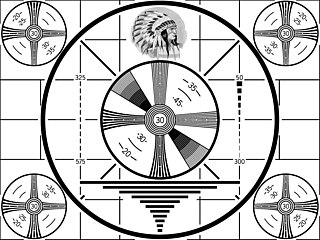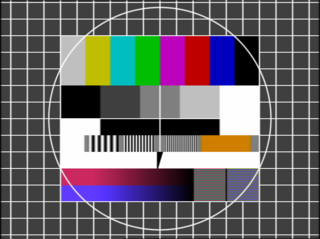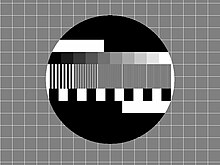
Analog television is the original television technology that uses analog signals to transmit video and audio. In an analog television broadcast, the brightness, colors and sound are represented by amplitude, phase and frequency of an analog signal.
A signal generator is one of a class of electronic devices that generates electrical signals with set properties of amplitude, frequency, and wave shape. These generated signals are used as a stimulus for electronic measurements, typically used in designing, testing, troubleshooting, and repairing electronic or electroacoustic devices, though it often has artistic uses as well.

A test card, also known as a test pattern or start-up/closedown test, is a television test signal, typically broadcast at times when the transmitter is active but no program is being broadcast.

Test Card F is a test card that was created by the BBC and used on television in the United Kingdom and in countries elsewhere in the world for more than four decades. Like other test cards, it was usually shown while no programmes were being broadcast. It was the first to be transmitted in colour in the UK and the first to feature a person, and has become an iconic British image regularly subject to parody.

SMPTE color bars are a television test pattern used where the NTSC video standard is utilized, including countries in North America. The Society of Motion Picture and Television Engineers (SMPTE) refers to the pattern as Engineering Guideline (EG) 1-1990. Its components are a known standard, and created by test pattern generators. Comparing it as received to the known standard gives video engineers an indication of how an NTSC video signal has been altered by recording or transmission and what adjustments must be made to bring it back to specification. It is also used for setting a television monitor or receiver to reproduce NTSC chrominance and luminance information correctly.

The Indian-head test pattern is a test card that gained widespread adoption during the black-and-white television broadcasting era as an aid in the calibration of television equipment. It features a drawing of a Native American wearing a headdress surrounded by numerous graphic elements designed to test different aspects of broadcast display. The card was created by RCA to be the standard image for their TK-1 monoscope, a simple video camera capable of producing only the image embedded within it. The pattern was introduced in 1939 and over the following two decades became a fixture of television broadcast across North America in 525-line resolution and abroad in 525-and 625-line resolution until it was obsoleted by the rise of color television in the 1960s.

A monoscope was a special form of video camera tube which displayed a single still video image. The image was built into the tube, hence the name. The tube resembled a small cathode ray tube (CRT). Monoscopes were used beginning in the 1950s to generate TV test patterns and station logos. This type of test card generation system was technologically obsolete by the 1980s.

The Philips circle pattern refers to a family of related electronically generated complex television station colour test cards. The content and layout of the original colour circle pattern was designed by Danish engineer Finn Hendil (1939–2011) in the Philips TV & Test Equipment laboratory in Amager near Copenhagen under supervision of chief engineer Erik Helmer Nielsen in 1966–67, largely building on their previous work with the monochrome PM5540 pattern. The first piece of equipment, the PM5544 colour pattern generator, which generates the pattern, was made by Finn Hendil and his group in 1968–69. The same team would also develop the Spanish TVE colour test card in 1973.
A video signal generator is a type of signal generator which outputs predetermined video and/or television oscillation waveforms, and other signals used in the synchronization of television devices and to stimulate faults in, or aid in parametric measurements of, television and video systems. There are several different types of video signal generators in widespread use. Regardless of the specific type, the output of a video generator will generally contain synchronization signals appropriate for television, including horizontal and vertical sync pulses or sync words. Generators of composite video signals will also include a colorburst signal as part of the output.
RÚV is the main television channel of RÚV, the Icelandic public broadcaster, launched in 1966. The free-to-air channel broadcasts primarily news, sports, entertainment, cultural programs, children's material, original Icelandic programming as well as American, British and Nordic content. Among its highest-rated programs are the comedy sketch show Spaugstofan, mystery drama Ófærð (Trapped) and Fréttir (News).

ETP-1 was a test card designed and used by the Independent Broadcasting Authority (IBA). After test transmissions from the IBA's Engineering Regional Operations Centre (ROC) in Croydon from 1978 it was phased in on ITV over a period starting from 1979, replacing, in different ITV regions: Test Card F, Test Card G and full screen height EBU colour bars. After ITV went 24 hours in 1988, the card ceased to be seen on the channel. It was used for both 625-line PAL and 405-line monochrome broadcasts.
441-line is the number of scan lines in some early electronic monochrome analog television systems. Systems with this number of lines were used with 25 interlaced frames per second in France from 1937 to 1956, Germany from 1939 to 1943, Italy from 1939 to 1940, as well as by RCA in the United States with 30 interlaced frames per second from 1938 to 1941. Broadcasts were planned in Finland for 1940, but eventually cancelled due to World War II. Some experiments with similar systems were carried out on the USSR in the 1930s and Japan in 1939.
A digital pattern generator is a piece of electronic test equipment or software used to generate digital electronic stimuli. Digital electronics stimuli are a specific kind of electrical waveform varying between two conventional voltages that correspond to two logic states. The main purpose of a digital pattern generator is to stimulate the inputs of a digital electronic device. For that reason, the voltage levels generated by a digital pattern generator are often compatible with digital electronics I/O standards – TTL, LVTTL, LVCMOS and LVDS, for instance.

The Telefunken FuBK is an electronic analogue television test card developed by AEG-Telefunken and Bosch Fernseh in West Germany as the successor to the monochrome T05 test card in the late-1960s and used with analogue 625-lines PAL broadcasts.

The TVE colour test card was an electronic analogue TV test card adopted by Televisión Española with the introduction of PAL colour broadcasts in 1975. It is notable for its unique design, created by the Danish engineer Finn Hendil (1939–2011) in 1973, under the supervision of Erik Helmer Nielsen at the Philips TV & Test Equipment laboratory in Amager, south of Copenhagen, the same team that developed the popular Philips PM5544 test pattern. It replaced a previous black and white version developed by Eduardo Gavilán.

UEIT - Universal Electronic Test Chart is a Soviet/Russian test card, designed to test TVs operating in the analogue SECAM colour standard.

The EIA 1956 Resolution Chart is a test card originally designed in 1956 to be used with black and white analogue TV systems, based on the previous RMA 1946 Resolution Chart. It consisted of a printed chart filmed by a TV camera or monoscope to be displayed on a TV screen, and was also available as individual rolls of test film to test broadcasting equipment. Inspecting the chart allowed to check for defects like ringing, geometric distortions, raster scan linearity, cathode-ray tube uniformity and lack of image resolution. If needed, a technician could use it to perform the necessary hardware adjustments.

The EBU colour bars is a television test card used to check if a video signal has been altered by recording or transmission, and what adjustments must be made to bring it back to specification. It is also used for setting a television monitor or receiver to reproduce chrominance and luminance information correctly. The EBU bars are most commonly shown arranged side-by-side in a vertical manner, though some broadcasters – such as TVP in Poland, and Gabon Télévision in Gabon – were known to have aired a horizontal version of the EBU bars.

Snell & Wilcox SW2 and SW4 "Zone Plate" Test Chart were TV test cards introduced in the 1990s and used with NTSC, PAL and SDTV systems.















